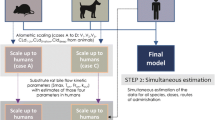Abstract
Purpose. The in vivo plasma protein binding and pharmacokinetics of flurbiprofen were studied in awake, unrestrained rats using intravenous microdialysis sampling.
Methods. Flurbiprofen (20 mg/kg) was administered i.v. to 2 groups of 6 rats: in both groups sampling was carried out by microdialysis, but in the second group an addional 10 blood samples were withdrawn via a jugular cannula. In vitro and ex vivo (following i.v. administration of flurbiprofen 20 mg/kg to another group of 13 rats) plasma protein binding of the drug was determined by equilibrium dialysis.
Results. The area under the unbound plasma concentration-time profile of flurbiprofen (AUCU), determined by microdialysis sampling, was somewhat smaller (−19%, p = 0.066) in the rats undergoing simultaneous serial blood sampling (2.21 ± 0.36 (µg.h/ml) as compared to the rats undergoing microdialysis sampling only (2.73 ± 0.60 µg.h/ml). Comparison of total and unbound concentrations of flurbiprofen showed an in vivo plasma binding varying between 99.5% at low and 98.0% at high total flurbiprofen plasma concentrations. Plasma binding of flurbiprofen determined in vitro over the same concentration range was higher (99.5–99.9%) but also concentration-dependent. Plasma binding of flurbiprofen determined ex vivo, on the other hand, corresponded well with the in vivo binding.
Conclusions. Monitoring the fraction of drug unbound in blood of an individual rat throughout a pharmacokinetic experiment has now become possible by using simultaneous sampling of blood and intravenous microdialysates.
Similar content being viewed by others
REFERENCES
W.J. Jusko and M. Gretch. Plasma and tissue protein binding of drugs in pharmacokinetics. Drug Metab. Rev. 5:43–140 (1976).
J.H. Lin. Dose-dependent pharmacokinetics: experimental observations and theoretical considerations. Biopharm. Drug Disp. 15:1–31 (1994).
H. Kurz, H. Trunk, and B. Weitz. Evaluation of methods to determine protein-binding of drugs. Arzneim. Forsch./Drug Res. 27:1373–1380 (1977).
R.K. Verbeeck, G.R. Loewen, J.I. Macdonald, and R.J. Herman. The effect of multiple dosage on the kinetics of glucuron-idation and sulphation of diflunisal in man. Br. J. Clin. Pharmacol. 29:381–389 (1990).
B. Benveniste. Brain microdialysis. J. Neurochem. 52:1667–1679 (1989).
L. Ståhle. The use of microdialysis in pharmacokinetics and pharmacodynamics. In T.E. Robinson and J.B. Justice Jr. (eds.), Microdialysis in the Neurosciences, Elsevier Science Publishers B.V., Amsterdam, 1991, pp. 155–174.
S.L. Wong, K. van Belle, and R.J. Sawchuk. Distributional transport kinetics of zidovudine between plasma and brain extracellular fluid/cerebrospinal fluid in the rabbit: investigation of the inhibitory effect of probenecid utilizing microdialysis. J. Pharmacol. Exptl. Ther. 264:899–909 (1993).
P.A. Evrard, G. Deridder and R.K. Verbeeck. Intravenous microdialysis in the mouse and the rat: development and pharmacokinetic application of a new probe. Pharm. Res. 13:xxx–xxx (1996).
J.H. Lin, D.M. Cochetto, and D.E. Duggan. Protein binding as a primary determinant of the clinical pharmacokinetic properties of non-steroidal anti-inflammatory drugs. Clin. Pharmcokin. 12:402–432 (1987).
L. Aarons, D.M. Grennan, and M. Siddiqui. The binding of ibuprofen to plasma proteins. Eur. J. Clin. Pharmacol. 25:815–818 (1983).
R.L. Williams, R.A. Upton, J.P. Cello, R.M. Jones, M. Blitstein, J. Kelly, and D. Nierenburg. Naproxen disposition in patients with alcoholic cirrhosis. Eur. J. Clin. Pharmacol. 27:291–296 (1984).
G.J. Szpunar, K.S. Albert, and J.G. Wagner. Pharmacokinetics of flurbiprofen in man. II. Plasma protein binding. Res. Comm. Chem. Pathol. Pharmacol. 64:17–30 (1989).
K.M. Giacomini, F.M. Wong, and T.N. Tozer. Correction for volume shift during equilibrium dialysis by measurement of protein concentration. Pharm. Res. 4:179–181 (1984).
J. Cumps and X. Marcelis. On the efficiency of algorithms for non-linear regression of pharmacokinetic data. Eur. J. Drug Metab. Pharmacokin. 18:140 (1993).
H.G. Boxenbaum, S. Riegelman, and R. Elashoff. Statistical estimations in pharmacokinetics. J. Pharmacokinet. Biopharm. 2:123–148 (1974).
M. Hulse, S. Feldman, and J.V. Bruckner, J.V.: Effect of blood sampling schedules on protein drug binding in the rat. J. Pharmacol, Exptl. Ther. 218:416–420 (1981).
Telting-Diaz, M., Scott, D.O. and Lunte, C.E.: Intravenous microdialysis sampling in awake, freely-moving rats. Anal. Chem. 64:806–810 (1992).
Yasuhara, M., Fujiwara, J., Kitade, S., Katayama, H., Okumura, K. and Hori, R.: Effect of altered plasma protein binding on pharmacokinetics and pharmacodynamics of propranolol in rats after surgery: role of alpha-1-acid glycoprotein. J. Pharmacol. Exptl. Ther. 235:513–520 (1985).
Risdall, P.C., Adams, S.S., Crampton, E.L. and Marchant, B.: The disposition and metabolism of contraceptive in several species including man. Xenobiotica 11:691–704 (1978).
Berry, B.W. and Jamali, F.: Enantiomeric interaction of flurbiprofen in the rat. J. Pharm. Sci. 78:632–634 (1989).
Menzel-Soglowek, S., Geisslinger, G., Beck, W.S. and Brune, K.: Variability of inversion of (R)-flurbiprofen in different species. J. Pharm. Sci. 81: 888–891 (1992).
Lima, J.J.: Experimental evidence for concentration-dependent plasma protein binding effects on the apparent half-lives of restrictively cleared drugs. J. Pharm. Sci. 72:461–462 (1983).
Knadler, M.P., Brater, D.C. and Hall, S.D.: Plasma protein binding of flurbiprofen: enantioselectivity and influence of pathophysiological status. J. Pharmacol. Exptl. Ther. 249:378–385 (1989).
Author information
Authors and Affiliations
Rights and permissions
About this article
Cite this article
Evrard, P.A., Cumps, J. & Verbeeck, R.K. Concentration-Dependent Plasma Protein Binding of Flurbiprofen in the Rat: An in Vivo Microdialysis Study. Pharm Res 13, 18–22 (1996). https://doi.org/10.1023/A:1016008712756
Issue Date:
DOI: https://doi.org/10.1023/A:1016008712756




